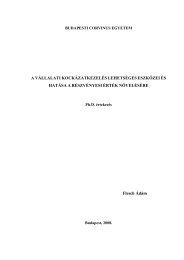Klára Pásztor-Huszár - Budapesti Corvinus Egyetem
Klára Pásztor-Huszár - Budapesti Corvinus Egyetem
Klára Pásztor-Huszár - Budapesti Corvinus Egyetem
Create successful ePaper yourself
Turn your PDF publications into a flip-book with our unique Google optimized e-Paper software.
The results obtained by the two different techniques, gel electrophoresis and<br />
spectrofluorometry, were in good agreement with each other. Using gel electrophoresis,<br />
intensity of the bands of the different pressurized milk protein fractions was decreasing with<br />
increasing pressure and holding time, indicating a loss in the fractions. In accordance with<br />
these results, intensities of Trp and retinol emission and excitation spectra were also<br />
decreasing with increasing pressure and holding time. The similar tendencies found by the<br />
two different methods support the assumption that spectrofluorometry can be a a viable<br />
alternative in protein research. However, the type of information provided by PAGE and<br />
spectrofluorometry is different. The classical methods of proteomics can not be replaced by<br />
fluorometric measurements, only in specific aimed situations, but where applicable,<br />
fluorescence spectroscopy affords rapid, reliable, well-reproducible results in contrast to the<br />
time-consuming electrophoretic methods.<br />
Based on these findings, I would like to pursue my research both by concentrating on the<br />
spectrofluorometric approach and by broadening my interest towards the application of HHP<br />
to the processing of other dairy products (e.g. fermented products such as yoghurt or cheese.<br />
Regarding spectrofluorometry, I endeavour to compile a database of milk by systematically<br />
adjusting treatment parameters and by measuring the pertinent fluorescence intensities. With<br />
the help of an appropriately large data collection, compiled using mathematical statistical<br />
methods, such as principal component analysis and discriminance analysis, identification and<br />
classification of an unknown sample would be possible. One could also determine, what kind<br />
of treatment was used and whether the product underwent an adequate treatment or not. Thus,<br />
spectrofluorometry could be made a new and more efficient method of quality control in the<br />
dairy industry. Regarding the application of HP treatment to dairy products other than milk,<br />
there is still much to learn about the effect of HHP on their coagulation, texture, ripening, and<br />
functional characteristics of proteins.<br />
Theses (new scientific results)<br />
1. Higher fat content of milk exerts a protective effect on milk proteins, primarily β-Lg,<br />
against pressure. The baroprotective effect of milk fat on milk proteins was confirmed<br />
by the examinations on immunoreactivity as well.<br />
2. To my knowledge no research was carried out and published on the treatment of<br />
mare’s milk by HHP. Immunoreactivity of mare’s milk was completely eliminated by<br />
11
















